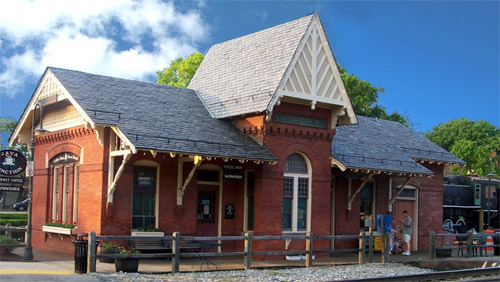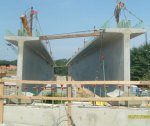|
Special Features





Image Libraries


|
|
Blog
On Monday the DC Zoning Commission approved final plans for the long-awaited Convention Center Hotel. The new hotel will be at the corner of Massachusetts Avenue and 9th Street, NW, will have 1, 150 rooms, and will feature a domed atrium. Unlike some earlier plans, it will save the historic AFL Building (on the left in this photo), which will be used as a separate 42-room boutique hotel.
Saving the AFL building is especially good news considering the hotel would otherwise cover the entire block with what seems to be a supremely uninteresting glass curtain wall.

Raise your hand if “more curtain wall” is what you think downtown needs. Anybody?
Rendering courtesy Cooper Carry.
Average Rating: 4.9 out of 5 based on 277 user reviews.
November 26th, 2008 | Permalink
Tags: architecture, development, preservation, urbandesign

Another reason the car-sewer highways of Tysons Corner need to be converted into slower-speed multi-modal streets: Lives would be saved.
Even the road-happy Federal Highway Administration and Institute of Transportation Engineers agree that suburban cars-first road design is dangerous to pedestrians and cyclists. Some studies even go so far as to suggest that suburban road design is so dangerous to everyone (including drivers) that outer suburbs are overall more dangerous than crime-ridden inner cities.
Average Rating: 4.5 out of 5 based on 255 user reviews.
November 26th, 2008 | Permalink
Tags: urbandesign

Click the image below for a small gallery of photos from Gaithersburg’s beautiful B&O Station, considered along with nearby Point of Rocks to be among the country’s most story-book-like Victorian depots.

Saint Pancras Station, by the way, is one of London’s main rail terminals, and is considered by many to be the pinnacle of red brick Victorian architecture. BeyondDC doesn’t actually think Gaithersburg is better.
Average Rating: 4.7 out of 5 based on 157 user reviews.
November 25th, 2008 | Permalink
Tags: galleries, transportation

On November 19, Senators Kerry (D-MA) and Specter (R-PA) introduced to the Senate the High-Speed Rail for America Act. The act, if passed, will build on the Passenger Rail Investment and Improvement Act to fund $10 billion for improvements to high-speed rail in the Northeast Corridor (including Washington) and in California, and a further $5.4 billion for rail corridors in the Midwest and Southeast.
That’s not enough cash to make Shinkansen-like bullet trains criss-cross the continent, but it is enough to bring Amtrak’s most heavily-used corridors up to a standard that would allow something on the order of 100 mile per hour trains. That, certainly, would be a big improvement.
Average Rating: 4.9 out of 5 based on 224 user reviews.
November 24th, 2008 | Permalink
Tags: government, transportation

|

Baltimore LRT’s bad rep is due to cut corners; LRT can be better. Photo from flickr. |
The Maryland Transit Administration has a long and glorious history of cutting corners on Baltimore’s light rail line. They didn’t directly connect it with the city’s subway, they waited years to double track the northern corridor, they missed Towson, and on and on. As a result, Baltimore’s light rail line generates far fewer riders than it should. Its approximately 32, 000 daily riders rank below light rail lines in such transit juggernauts as Salt Lake City, Houston and San Jose, and come in at less than half the Purple Line’s projected ridership of 68, 000 per day.
But none of those cut corners were as preventable as the latest to enter the news. The entire northern corridor of Baltimore’s light rail (15 miles of 29 total) is currently shut down because trains have been sliding on fallen leaves. Like from trees. The reason? In 2000 MTA officials decided not to spend $4 million on a system that would prevent slipping. Somebody cut a corner, and now 47 of the agency’s 53 rail cars need costly repairs, and an entire corridor is totally shut down. Whoops.
MTA has been making progress since 2000, and especially since transit-hostile Governor Ehrlich was replaced by transit-friendly Governor O’Malley, but it doesn’t take long to find cut-corners thinking still present. BRT remains an option for the Purple Line, even though planners estimate it would carry some 30, 000 fewer riders than light rail, and half the stations on the Corridor Cities Transitway just barely miss the most transit-supportive neighborhoods along the alignment. If Maryland is to have the transit system it needs and deserves, corners are going to have to stop being cut. You get what you pay for.
For the record, this is different than the Anacostia streetcar, where the question isn’t what to build at all, but what to build first.
Thanks to reader Cyrus for the tip.
Average Rating: 4.9 out of 5 based on 264 user reviews.
November 21st, 2008 | Permalink
Tags: transportation

|

Dulles. |
Average Rating: 4.5 out of 5 based on 262 user reviews.
November 20th, 2008 | Permalink
Tags: transportation

Since its inception in 1998, LEED certification has become the standard in environmentally-friendly architectural design. Buildings are awarded points for having green features, and the more points they accrue the higher LEED certification they get. It’s a good system, and in 10 years it has become a pretty big deal.
We should be rewarding communities with green ordinances and chastising those with environmentally damaging ones.
|
|
But if LEED is a good system, it’s not a perfect one. There are a few points available for buildings that locate in an urban setting, but for the most part LEED focuses on things like low-energy light bulbs, water use reductions, reduced heat islands, etc. And as BeyondDC has said in the past, LEED architecture without good urban design is like cutting down the rainforest using hybrid-powered bulldozers – it just sort of misses the point. The good news is that, as GGW points out, the folks at LEED are working on a Neighborhood Development rating system that will be for large-scale developments what regular LEED is for individual buildings. Soon, subdivision developers will be able to apply for LEED ratings, and they’ll only get certification if their projects meet minimum standards of good urbanism.
LEED-ND, as the Neighborhood Development system is being called, is a fabulous step forward, but it begs the question of why so many developers build projects with bad urbanism to begin with. The answer in many cases is that they’re required to do so due to the zoning regulations of the jurisdiction in which their project is located. Take a look at just about any zoning code in America and you will find a mountain of regulations literally outlawing good urbanism, from the obvious (like setback and parking requirements) to the obscure (like a common requirement that townhouse developments can only have rows of up to 4 or 5 attached houses). So if there’s a problem with the zoning in many American communities, LEED should look into adopting a certification program specifically for zoning. We should be rewarding communities with green ordinances and chastising those with environmentally damaging ones.
Laurence Aurbach of PedShed.net points us to the STAR Community Index, a program currently being set up that’s scheduled to launch in 2010. STAR will offer certification to communities with green programs, presumably including (but not limited to) their zoning ordinances. It sounds like a great initiative, and with any luck it will do for zoning what LEED has done for architecture. One of the biggest problems sustainability faces in this country is that there are so many good-intentioned environmentalists out there who oppose urban densities on the grounds that parks are always better than buildings, but who ultimately hurt the environment by causing more sprawl. LEED-ND and STAR will go a long way in getting the message out that urbanism is good for the environment.
Average Rating: 5 out of 5 based on 165 user reviews.
November 20th, 2008 | Permalink
Tags: environment, government

In the last month Maryland has cut $3.5 billion from its six year capital transportation program. The state had been prepared to spend $10.5 billion; now its budget is down to $7 billion. Virginia is facing similar cuts to its own program. Transportation agencies in both states promise to finish projects already under construction, but say anything that hasn’t started yet is in serious danger.
The reason for all these budget cuts is that a large portion of transportation funding comes from cars. The gas tax, sales tax on new cars, registrations, etc. In the 20th Century that made total sense, but if we want to encourage people to drive less in the 21st (and we do), then we’ll need replacement sources of funds, lest every success diminish the next year’s budget.
The solution could be higher gas taxes, tolling, dedicated sales taxes, or any number of other possibilities, but until we accept that new sources of money are needed (and that less money should be wasted on traffic-inducing road projects), the budget outlooks of VDOT, MDOT and all the other DOTs will continue to become increasingly bleak.
Average Rating: 4.5 out of 5 based on 237 user reviews.
November 19th, 2008 | Permalink
Tags: transportation

A little too busy with real life to spend time blogging. In the mean time, just for fun, enjoy this view of Vulcan urbanism, courtesy the upcoming Star Trek movie.

Live long and prosper.
Average Rating: 4.8 out of 5 based on 182 user reviews.
November 18th, 2008 | Permalink
Tags: fun

|

Actual picture of the ICC under construction. |
The InterCounty Connector is going to be built. Whether the decision was wise or foolish, get used to the idea, ’cause it’s gonna happen. Environmentally speaking, about the only positive thing that can be said about the ICC is that maybe it will divert some growth that would have been leap-frog sprawl in the upper I-270 corridor towards parts of Burtonsville that are already suburban. Overall, the ICC will still increase Vehicle Miles Traveled (VMT), which is a step in the wrong direction. It will contribute to the problem of induced demand, will take money away from transit projects like the Purple Line, will encourage more auto-oriented land use, and will disrupt watersheds in eastern Montgomery County. It is, overwhelmingly, an environmental loser.
The fact that planners cancelled the ICC’s bike trail was salt in the wound. That they did it for ostensibly environmental reasons was just insulting.
So, having learned that this thing will happen no matter what, and that project planners do not have a big-picture understanding of environmentalism, the Environmental Defense Fund probably made the right decision in settling its lawsuit and getting something in return as a concession, instead of nothing at all. That $2 million will be spent on cleaner school buses doesn’t exactly free the ICC of environmental guilt, not even close, but at least it’s something.
Small victories are better than no victories.
Average Rating: 4.7 out of 5 based on 264 user reviews.
November 17th, 2008 | Permalink
Tags: environment, transportation

|
Media





Site
About BeyondDC
Archive 2003-06
Contact
Category Tags:
Partners
|




















